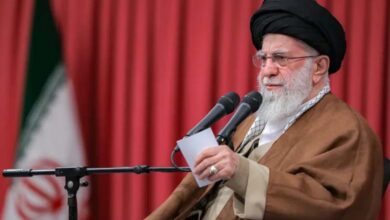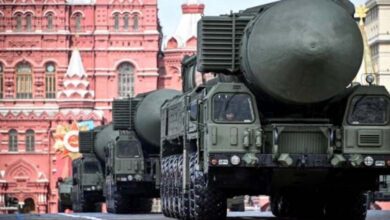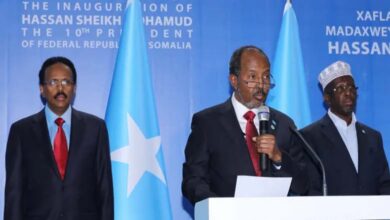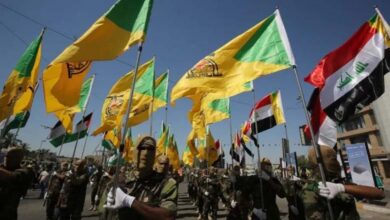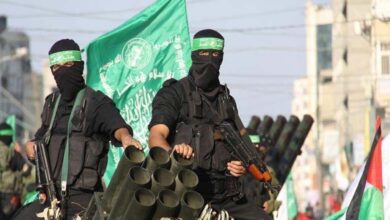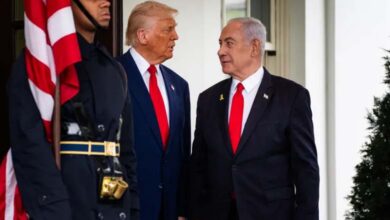Symbols and Sketch… Israel Publishes a Paper Found in Sinwar’s Pocket
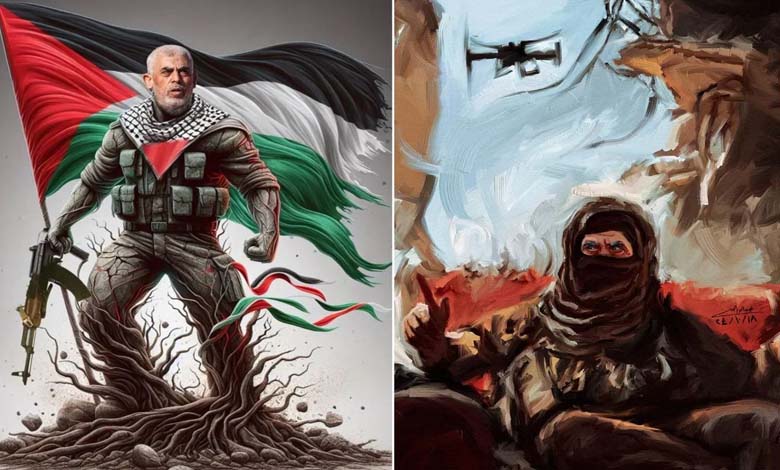
Israel has disclosed the discovery of a small piece of paper found in Yahya Sinwar’s pocket after his death in Rafah. This blood-stained note reportedly contained jagged lines and symbols resembling a map of tunnels and secret shelters.
-
The body of Yahya Sinwar… Israel’s lottery ticket for freeing its prisoners?
-
Shin Bet Denies the Death of Yahya Sinwar
Throughout months of war, Yahya Sinwar, leader of Hamas in Gaza, remained in hiding underground, relying on the intricate tunnel system that the movement had developed over the years. His pursuit ended in Rafah’s Tel al-Sultan neighborhood, where Israeli forces killed him in what was described as “the most complex operation” since the outbreak of the conflict.
According to Israel’s Channel 12, the paper was presented dramatically as evidence of the manhunt. It contained a sketch of the tunnel network with coded names marking safe houses and fallback shelters. The broadcaster characterized the note as “a testimony of a pursuit that ended,” claiming it was an emergency map drawn by Sinwar himself to guide movements and retreats when necessary.
-
From Underground… How Does Yahya Sinwar Communicate with Hamas Leaders Inside and Outside Gaza?
-
Unveiling Sinwar’s Plan: How He Prepared the October 7, 2023 Attack in the Shadows
Concerns Among External Leadership
Beyond Gaza, the Israeli threat has stirred deep concerns among Hamas and Islamic Jihad leaders based abroad. Channel 12 reported that unprecedented security measures were adopted, including relocating senior officials across multiple countries to avoid potential assassinations.
Reports suggested that personal protection for key figures was tightened, particularly for those who had been released in previous prisoner exchanges and now reside in other states.
-
Hamas confirms the death of Mohammed al-Sinwar, al-Haddad expected to succeed him
-
The “Life Sentences” List Signals a Crisis in Israel… Is a New Sinwar on the Horizon?
Israeli Chief of Staff Eyal Zamir hinted that the military would increasingly target Hamas leaders abroad after eliminating most of the movement’s leadership within Gaza. “We are operating offensively, taking the initiative, and maintaining operational superiority across all arenas at all times,” he declared.
He added: “In Gaza, we struck one of Hamas’s most prominent leaders, Abu Ubaida, after eliminating most of its command. But this is only the beginning. Many still sit abroad, and we will reach them too.”
According to Zamir, these efforts form part of a wider series of operations carried out in Yemen, Lebanon, Syria, and other fronts.
A Recurrent Strategy
Such targeted killings would not be unprecedented. In recent years, Israel assassinated Hamas’s political bureau chief, Ismail Haniyeh, in Iran, as well as his deputy, Saleh al-Arouri, in Beirut. Numerous second-tier leaders have also been eliminated in Lebanon and Syria.
Channel 12 highlighted some of the remaining figures:
- In Gaza:
- Izz al-Din al-Haddad, commander of the Gaza Brigade and a pivotal leader within Hamas’s armed wing. As a member of the movement’s small military council, he directed the group’s military reconstruction and led operations in eastern Gaza City. Israel has attempted to assassinate him several times, unsuccessfully.
- Raed Saad, head of operations and a senior member of Hamas’s military wing. For more than two decades, he has played a central role in building Hamas’s military infrastructure, from rocket development to anti-tank systems and tunnel warfare. He was one of the chief planners of the October 7, 2023, attack. An Israeli strike targeting him in June 2024 failed.
-
Forensic Medicine Reveals Sinwar’s Death from a Gunshot to the Head
-
The Killing of Sinwar returns power to Hamas Leaders Abroad
- Abroad:
This evolving landscape illustrates Israel’s determination to strike Hamas’s leadership wherever they are found, maintaining pressure on a movement whose command has been fragmented but remains operationally active.
Key Figures of Hamas Leadership Inside and Abroad
Khaled Meshaal
Aged 69, Khaled Meshaal currently serves as the leader of Hamas abroad. He previously held the position of head of the political bureau for over two decades, from 1996 to 2017. Israel made several unsuccessful attempts to assassinate him, most notably in September 1997, when Mossad agents tried to poison him in Jordan. The plot was foiled when Meshaal’s security team captured the agents involved. To secure their release, Israel agreed to provide the antidote that saved Meshaal’s life, triggering a major diplomatic crisis between Amman and Tel Aviv. He now resides in Qatar.
Osama Hamdan
Osama Hamdan is a senior Hamas official abroad, frequently interviewed by the media to convey the movement’s positions. Born in the Bureij refugee camp in Gaza, he later moved with his family to Kuwait, where he completed secondary school. He studied chemistry at Yarmouk University in Jordan, where he connected with Palestinian students aligned with the Muslim Brotherhood. In 1994, he began representing Hamas in Iran, and in 1998, he became the group’s official representative in Lebanon.
-
Sinwar and the hostages… The revelation of a “safe exit deal” for Hamas leaders from Gaza
-
Israel Proposes Safe Exit to Sinwar in Exchange for Hostages’ Release
Moussa Abu Marzouk
Moussa Abu Marzouk served as head of Hamas’s political bureau from 1992 to 1995 while based in Amman. In 1999, upon returning from Iran, he was again expelled from Jordan. He later lived in Damascus, then Cairo, and is currently based in Qatar.
Nizar Awadallah
In Hamas’s 2021 internal elections for political bureau chief in Gaza, Nizar Awadallah defeated Yahya Sinwar in the first round by seven votes, though Sinwar ultimately prevailed in the fourth round. Awadallah remains one of Hamas’s prominent leaders in Gaza.
-
Washington Accuses Hamas Leaders of Terrorism, Including Sinwar
-
Israel Tracks Sinwar Underground with Advanced American Radar
Mahmoud al-Zahar
A veteran member and co-founder of Hamas, Mahmoud al-Zahar is known for his hardline stance and his close ties to Iran. Trained as a physician and surgeon in Egypt, he became a prominent figure in Hamas’s political leadership. During the Second Intifada, he acted as the group’s official spokesperson. Born in the Zeitoun neighborhood of Gaza, he grew up in Ismailia, Egypt. He is believed to be currently in Gaza.
Fathi Hammad
Fathi Hammad, currently outside Gaza, was born in the Jabaliya refugee camp. He was involved in the wave of Hamas operations carried out in response to the assassination of Yahya Ayyash, known as “the Engineer.” A radical figure within the movement, he previously headed Hamas’s media department and later became Interior Minister in the Hamas-led government, overseeing security agencies including the police and internal security forces.
-
Where is Sinwar in the Gaza Negotiations? Hamas Leader Reveals His Role and Communication Methods
-
Between Sinwar’s Approval and Israel’s Rejection… An Uncertain Fate Awaits Gaza Truce Negotiations
Beyond these figures, other influential leaders remain undisclosed for security reasons. Hamas’s political bureau is the highest executive authority, responsible for final decisions, while critical strategic choices are made collectively with the Shura Council, composed of 50 members.
During the ongoing conflict, Israel has already killed several leading members of Hamas’s political bureau, including Ismail Haniyeh and his successor Yahya Sinwar, as well as Salah al-Bardawil, Ismail Barhoum, Mohamed al-Jamassi, Essam al-Da‘alis, Yasser Harb, Zakaria Abu Muammar, Jawad Abu Shamala, Jamila al-Shanti, Osama al-Muzaini, Marwan Issa, and Rouhi Mushtaha.
-
The Muslim Brotherhood blesses the appointment of Sinwar… An expert affirms it is illegitimate and contrary to the regulations of Hamas and the Muslim Brotherhood
-
In a message to the arabs… Sinwar reveals Hamas’s stance on Biden’s plan to end the Gaza War
-
Sinwar’s Movements Disrupt Israeli Equations, Not in Rafah



